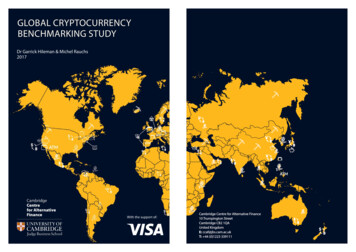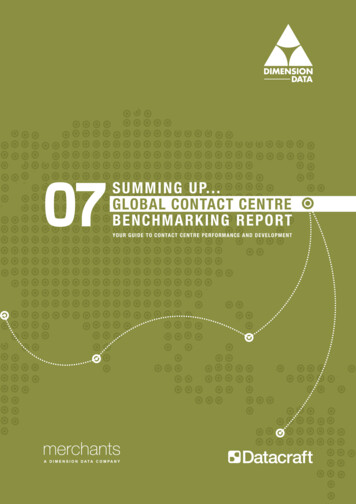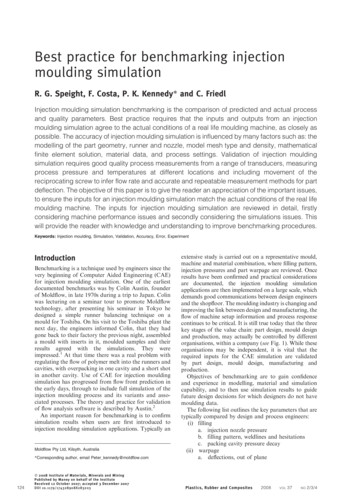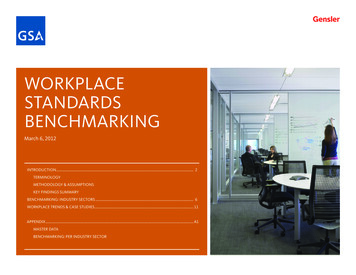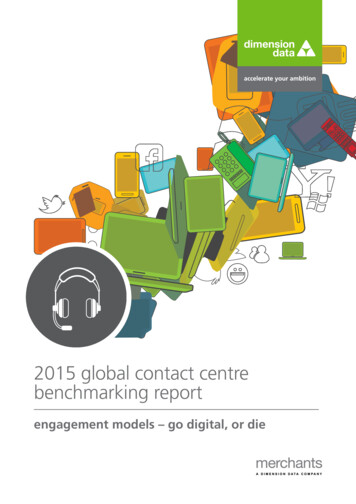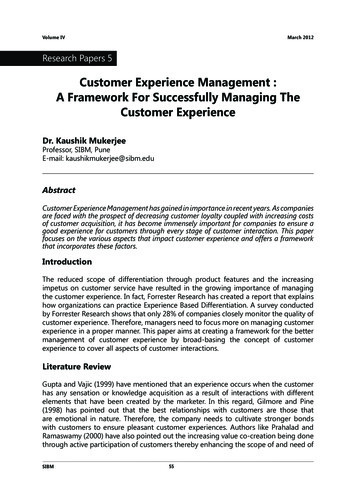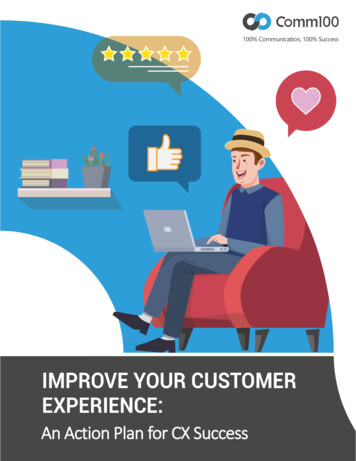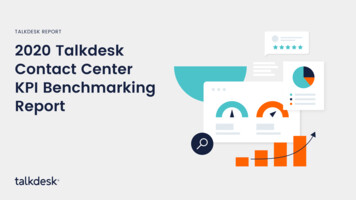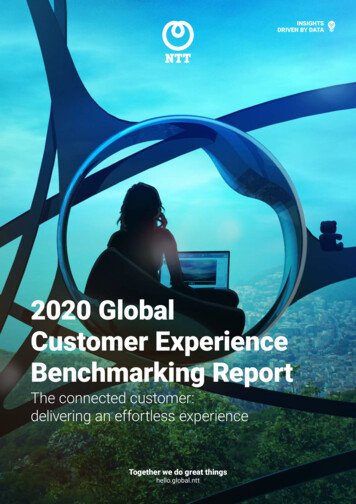
Transcription
INSIGHTSDRIVEN BY DATA2020 GlobalCustomer ExperienceBenchmarking ReportThe connected customer:delivering an effortless experienceTogether we do great thingshello.global.ntt
2020 Global Customer Experience Benchmarking ReportWhat analysts say about the Report‘ Once again, NTT Ltd. provides key insights into what customerswant and need, helping to guide organizations as they engagewith customers. The data helps businesses identify whereand how to invest their resources in order to differentiate andprovide the effortless experiences customers are expectingand demanding. NTT Ltd.’s Global Customer ExperienceBenchmarking Report is my go-to resource for unbiased dataand CX research.’ Blair PleasantPrincipal Analyst, COMMfusion‘ The Benchmarking Reportcontinues to be mynumber one go-to sourceof validation for customertrends in the industry.This year’s report did notdisappoint as it providedeven more validation forthe continued trends we areseeing in customer contact.’ Nancy JamisonPrincipal Analyst, Customer Contact, Frost & Sullivan‘ NTT Ltd. continues toredefine the CustomerExperience BenchmarkingReport, mirroring changesin the enterprise softwareindustry being driven by thecloud, mobility and digitaltransformation. The 2020report brings timely insightson automation trends andworkplace optimizationwhile continuing to deftlychronicle the shift fromvoice and in-personcustomer experienceto digital.’ Sheila McGee-SmithPrincipal Analyst, McGee-Smith Analytics2 Copyright NTT Limited 2019hello.global.ntt
2020 Global Customer Experience Benchmarking ReportContentsWhat analysts say about the Report02Foreword04A model for success: lessons from the top CX performers061. Lead with strategy08How leading B2B companies organize for CX success282. Understand customers303. Personalize experiences45Spotlight on security: Data security and the connected customer:practical considerations for implementing cybersecurity in CX614. Engage through omnichannel635. Automate intelligence80Spotlight on AI: Empathy, ethics and employee anxiety98Case study: SMBC Nikko Securities Inc.1006. Optimize performance101Regional hotspots132From data to action next steps138About the NTT 2020 Global Customer Experience Benchmarking Report139About the CX Benchmarking Portal140About us141hello.global.ntt Copyright NTT Ltd. 3
2020 Global Customer Experience Benchmarking ReportForewordForewordThis is the first year the Report is being published under the NTT Ltd.brand and we’re pleased to present a collection of perspectives fromthought leaders with diverse experience within the NTT Group. We alsohave more contributors sharing their insights and discussing what thetrends mean, based on their work with clients from a vast range ofindustries across the globe. I trust you will find this information valuableas you work towards optimizing CX within your organization.From data to insights and actionFrom sales to support, customers expect consistency in their interactions with organizations.Our theme for this year’s Report – ‘The connected customer: delivering an effortlessexperience’ – sums up the necessity of getting CX right in every area of the organization, onevery modality, across the value chain (which may well involve external providers, too).That’s easier said than done when you’re dealing with a complex system of many independentmoving parts. There’s a great deal of effort involved in delivering effortless CX. But organizationsmaking that effort are reaping the rewards, as we see in the performance of those in the topquartile this year.Focus on business outcomesCX is still recognized as a clear differentiator (by 81.6% of organizations) and the number oneindicator of strategic performance. Board-level accountability for CX is rising. Yet, only 12.1%say customers rate their CX at a promoter level.This year’s findings show that ease of resolution is still the most important factor in customersatisfaction. So, connect with your customers the way they expect, using channels they wish toengage on. To provide a seamless and effortless journey, focus on these key business outcomes: Lead with strategy: CX is an enterprise-wide deliverable that requires a clear, integrated strategyand well-defined execution across the organization. Boardrooms need to follow through onsentiment and ensure that CX strategies are clearly formulated, managed and delivered. Understand customers: The voice of your customers and employees remains at the center ofCX strategy and design. Data quality and governance are essential to CX analytics, as is a datamanagement platform that integrates information and insights. Personalize experiences: Understanding what it is that your customers value will enable youto deliver the exception, not the rule – and meet increasing demands for hyper-personalizationin CX. Engage through omnichannel: Customers want to engage on their channels of choice but it’sthe customer journey, not technology availability, that dictates whether new channels shouldbe deployed.4 Copyright NTT Ltd.hello.global.ntt
2020 Global Customer Experience Benchmarking ReportForeword Automate intelligence: AI and machine learning will become the catalyst forunderstanding customers, improving business operations and enabling humanworkforces. However, these technologies are still in the early stages of development,so be circumspect in your deployment. Optimize performance: Optimization is an ongoing practice, a philosophy of continuousimprovement, an evolution of technology, business and people to better servecustomers. As the pace of change accelerates, the focus of optimization shouldmove to agile and adaptable approaches.A well-defined CX strategy and clear leadership are the foundation for a truly connected,effortless CX that will create value for your customers and business.Nemo VerbistSenior Vice President, Intelligent Business andIntelligent WorkplaceNemo is responsible for the vision, strategy and go-to-market executionfor the Intelligent Business and Intelligent Workplace practices.Follow Nemo on LinkedIn.To remain relevant in a complex, changing environment, you need to.123456Lead cesEngage ormance.to create more value for your customers and business.hello.global.ntt Copyright NTT Ltd. 5
2020 Global Customer Experience Benchmarking ReportA model for successA model for success:lessons from the top CX performersThis year’s findings highlight the difficulty of meeting high expectations foron-demand transactions and hyper-personalization.Many organizations are failing to meet these expectations, for several reasons. Yet, organizations in the topquartile are significantly ahead of their industry peers and set the benchmark others should aspire to.Those falling behind will only become more vulnerable – hence the need to act and transform now.Here are four lessons we can learn from this year’s top performers:1Define the value of CX and understand why it’s a crucial part of strategyOrganizations that understand and can track the value being realized from their focus on CX, recognizingit as a crucial element of CX strategy, are delivering significantly better customer experiences.Results:28.3% score promoter-level results from their customers (against a 9.5% average of those who do not)while just 19.3% report detractor-level results (compared with 64.2%).Takeaway:Track the value CX brings to your organizational goals.2Collaborate on CX designSpeed-to-answer time is a key factor affecting perceptions of ease of resolution, which is whatcounts most when it comes to CX and customer satisfaction.Organizations adopting a fully collaborative approach to the design of CX processes, involving allbusiness functions, are slashing these times.Results:Compared with those working in silos or with only limited collaboration, their responses are: 41.6% better on telephone 34.3% better on email 10.2% better on web chat 33.7% better on social mediaTakeaway:Design enterprise-wide CX solutions that transcend all customer touchpoints.6 Copyright NTT Ltd.hello.global.ntt
2020 Global Customer Experience Benchmarking Report3A model for successAccelerate the benefits of an improving CX capability with a formalVoC programOrganizations with a formal voice of the customer (VoC) program have been able to evidencesignificantly higher benefits from an improving CX capability than those operating without.Results: 64.9% (versus 51.3%) have seen improvements to customer loyalty and value 50.0% (versus 36.1%) have improved revenue/profits 38.4% (versus 29.6%) have also reduced costsTakeaway:Formalize how you listen to your customers.4Regard enterprise analytics as key to identifying CX inhibitorsLeading organizations have the data management and cross-channel analytics capabilities to reallyunderstand their customers and provide context-based personalization.Results: organizations with access to enterprise-wide CX analytics systems have reduced the percentageof disenchanted customers to 21.4% organizations functioning without these systems receive negative (I.e., detractor-level) CX scoresfrom 49.3% of their customer baseTakeaway:Inform your CX with data-led insights.hello.global.ntt Copyright NTT Ltd. 7
2020 Global Customer Experience Benchmarking ReportLead with strategy1. Lead withstrategy8 Copyright NTT Ltd.hello.global.ntt
2020 Global Customer Experience Benchmarking ReportLead with strategyFrom detractor to differentiator:the case for an optimizedcustomer experience strategy81.6%81.6% of organizations agree that CX offers acompetitive edge and 58.0% say it’s their primarydifferentiator, yet it forms a crucial part oforganizational strategy for just 14.4%.26.2%Only 26.2% say the value of CX is fully definedand tracked.44.5%Rising by 36.5%, some 44.5% of organizations nowoperate structured voice of the customer (VoC)programs to drive CX improvement and innovation.It’s encouraging that organizations continue to recognize CX as a core differentiator.Other positive signs are the increase in board-level representation of CX and a decline in thenumber of organizations that lead CX channel by channel.However, these high-level actions have yet to cause material change in CX for mostorganizations. Only 12.1% claim customer ratings are at an advocacy level. For 42.9%,ratings are at a detractor level – a significant jump from 27.2% a year ago.Despite a huge focus on emerging technologies to improve agent productivity andenhance self-service, most organizations have failed to reach these targets. There’s beenlimited progress in integrating digital initiatives with contact center initiatives, and usingdata, analytics and artificial intelligence (AI) to influence and impact CX.Effortless CX is the product of a customer experience culture. An optimized CX strategyneeds an organized execution framework that reaches all employees at the frontline ofcustomer interactions. Understand the value, risks and opportunities of CX to be personaland proactive.hello.global.ntt Copyright NTT Ltd. 9
2020 Global Customer Experience Benchmarking ReportLead with strategyPart 1: Industry insightsThe performance of industry leaders shows just what can beachieved. To reach those same heights, make effortless CX yourgoal. Listen to your customers and benchmark your progressagainst the organizations making significant progress in thisarea. Harness data, design intelligent processes, and implementautomation and AI at appropriate points.Do you have intelligent processes that enable proactive CX?Proactive CX reduces customer effort and frustration andincreases advocacyEffortless CX is largely proactive. It anticipates what customers want to know and deliversrelevant content at the right time to reduce contact-in.When contact center volumes grow and satisfaction levels fall, it affects businessperformance and increases the risk of churn. If a customer is forced to contact you,it’s usually because there’s a problem that requires them to act, which means there’sa higher risk of something going wrong.The number of organizations now dissatisfied with their CX capability hasgrown to 26.9%, a rise of 15.0% from last year.Effortless CX, delivered to your doorstepDelivery businesses are an excellent example of CX that’s so effortless, youhardly think about how you’re using it.Once you’ve placed an order, there’s very little for you to do. You receive a link totrack the progress of the order and change the safe place for delivery, if you wantto. You may even receive a photo of where the package has been delivered.The whole process is so seamless that the underlying complexity is invisible toyou. But think of everything that goes into making this work: integrating the delivery system with the website sending proactive notifications and visual updates offering customers choice enabling quick access to support, if neededThese are all characteristics of proactive CX built around a well-designedcustomer journey that’s been integrated with relevant technologies.Once you understand why customers contact you in the first place, you can designdigital environments that use data and automation intelligently to generate relevant,proactive content, and make it easy to break out to alternative channels.10 Copyright NTT Ltd.hello.global.ntt
2020 Global Customer Experience Benchmarking ReportLead with strategyIs automation used appropriately?Integrate the automation of CX with the side where people engage withcustomers, and harmonize the information being fed into CX processesAnalytics, automation and AI have seen a huge focus as organizations strive to createpersonalized, proactive and highly effective self-service experiences that will displacelegacy ways of doing things.For most, however, the implementation has not matched the aspiration. Just 5.7% of AI/robotics users say customers rate their CX at a promoter level (against 12.1% overall).Prestige brands and organizations that have optimized their CX strategies voteAI as the top factor to reshape their CX capability during the next five years.The key is harmonizing these technology capabilities with people, operations and design– because there will be times when you need a human touch. It’s when these elementsare out of balance that performance and advocacy levels fall.Be smart about where and how you introduce automation in your CX design, and whichchannels and technologies you use to interact with which contacts. An automated frontend may not work for high-value customers or complex interactions, for example.Do the hard work in the background so the front endis effortless.High effort and high complexity are the domain of automation and AI.Keep things simple for customers and ease the workflow for agents.hello.global.ntt Copyright NTT Ltd. 11
2020 Global Customer Experience Benchmarking ReportLead with strategyHow are employees informed and incentivized?To change culture and behaviour, use the right metrics at the right timeand placeGetting people to understand your CX strategy and be on board with what you’re tryingto achieve is an important step towards creating effortless CX that benefits both yourcustomers and your organization.It’s the step after that – translating CX aims into practical actions – where manyorganizations falter.Tracking of employee brand satisfaction is on trend, rising 22.2%, but just25.6% of organizations ensure employees understand the big picture,the direction of the business and how they plan to get there.Creating the right culture and behaviour requires two forms of metrics: those that informbehaviour and those that incentivize it: Inform: Send feedback from metrics such as Voice of the Customer (VoC) and NetPromoter Score (NPS) to every employee on the frontline. Structure it to clearly showhow it applies to their role. Incentivize: Put effective measurements in place to drive the key performanceindicators (KPIs) people are incentivized against. Top organizations identify a fewkey metrics that can apply to everyone in the organization and include these in theirperformance scorecards.From aspiration to executionTo transform CX aspirations into effective execution, people need to know what to do,what they’re being measured on, and how it all links back to the strategy.Redefine your CX frontline to include people who design CX channels as well as thosewho answer calls and emails. Establish a clear line of sight between VoC feedback andhow they put it into play.Bring your customer back into focus. And learn from leaders across industries who makeit all seem so easy.12 Copyright NTT Ltd.hello.global.ntt
2020 Global Customer Experience Benchmarking ReportLead with strategyPart 2: Trends and analysis1.1 CX as a competitive differentiator1.1 CX as a competitive differentiator81.6% of organizations acknowledge CX offers a competitive edge and 58.0% consider ita primary differentiator.While headline appreciation levels have remained relatively consistent since 2015, organizations unsure of CX value havealmost trebled, to 14.2%, meaning one in seven have doubts.4.2Yes – CX is aprimary differentiator14.223.66.8Yes – CX is asecondary differentiator2020Unsure58.04.9Yes2019NoNot sure88.3NoDoes your organization consider CX to be a competitive differentiator? n 1,012InsightActionCX a primary differentiator for those withoptimized strategiesLeading brands create high standardsand expectationsWhile most organizations (81.6%) conform to an ideologythat CX is generally acknowledged to be a competitivedifferentiator, a deeper investigation highlights that just58.0% see CX as a primary differentiator of their services.Some 80.3% of organizations that have progressed tooptimizing their CX strategy confirm CX as a primarydifferentiator – confirmation that a well-designed,calculated and effective approach will provide good returns.Customer choice for products and services has explodedin the digital world. Customers experience the sales andservice of organizations in multiple industries almostdaily. They also quickly and publicly express frustrationwhen they can’t get easy, personalized experiences, whichin turn influences brand choice and buying decisions.Perceptions of CX delivery as a differentiator vary quitenotably across industry sectors, with highs of 90.5% inhealthcare and pharmaceuticals and 89.3% in professionalservices. Outside of the public sector, where half fail tosee the importance of CX, just 69.6% in the energy andutilities sector appreciate the value of CX.There’s been a significant rise in the number oforganizations questioning the importance of CX.While the number saying CX is not a differentiatorhas fallen from 4.9% to 4.2%, the number now unsureof the value that can be associated with CX has almosttripled, to 14.2% (one in seven organizations).hello.global.nttBrands with easy, personalized ways to buy and supportproducts and services, using their customers’ channelof choice, set the standards for others to follow. To meetcustomers’ high expectations for this kind of experience: Understand what your customers want and collect VoCdata at every point in their journey. Research what leading organizations across industriesare doing and combine this knowledge with VoC datato design experiences that support and enhanceyour brand. Continually feed customer insights and best actions toyour frontline delivery and digital design teams. Be a customer of your own organization. Walk the landyou are asking your valuable customers to walk, and theopportunities for change and improvement will be clear. Copyright NTT Ltd. 13
2020 Global Customer Experience Benchmarking ReportLead with strategy1.2 Definition of CX valuef CX valueChap 1Just 14.4% of organizations say CX forms a crucial part of organizational strategy.Only 26.2% say the value of CX is fully defined and tracked. For nearly one in four (23.5%), there’s no formal appreciation of itsvalue or tracking of its contribution at all.CX value is fully defined andtracked, and a crucial partof the organizational strategyCX value is fully definedand tracked14.411.8CX value is partially definedand trackedCX value is not formallydefined or tracked50.323.5To what extent is the value of CX defined within your organization? n 969InsightActionValue of CX significantly more commonamong prestige brandsValue is silently won and lost on the currencyof CX: act accordinglyOur 2019 Report highlighted a strong correlation betweenbrand positioning and organizations that both define thestrategic value of CX and recognize it as being crucialto enabling their strategy. That same pattern continuesin 2020. Over one in three (35.5%) prestige brands saythe value of CX is fully defined and/or rank it as crucial,compared with 21.4% of mass-market brands, and just9.1% of budget operations.The customer who makes decisions based on thewisdom of crowds is a citizen of the experienceeconomy. Customers increasingly have access to ratings,reviews and social media posts that influence andinform their buying decisions, often in real time.Organizations that don’t track or understand customersentiment and feedback will be unable to adjust and,ultimately, compete for customer attention and loyalty.Sales teams lag their counterparts in customer servicesoperations, who are almost twice as likely to appreciatethe value of applying such disciplines (29.4% versus17.0% in sales).Defining and measuring the value and impact of CX interms of client retention, growth, repeat business andminimizing waste resulting from rework or poorly designedengagement, is fundamental to organizational success.At a sector level, the education, public sector andprofessional services industries stand out, as over one-thirdof operations (at 37.0%, 36.6% and 35.2% respectively)report that the value of CX is neither formally defined nortracked. At the other end of the scale, those in banking andinvestment lead the way in being most likely to have CXvalue fully defined (34.8%), followed closely by media andcommunications (including telecommunications), at 33.7%.It’s also critical that all employees understand and candeliver on the CX strategy and value proposition.14 Copyright NTT Ltd.A CX strategy that’s clearly defined and alignedthroughout the organization is key to the reliable deliveryof the brand promise.A balanced scorecard that uses relevant CX data andis communicated across the organization keeps thecustomer top of mind and allows for rapid remediationof negative sentiment or impacts on reputation.hello.global.ntt
2020 Global Customer Experience Benchmarking ReportLead with strategy1.3 CX strategy progresstegy progressChJust 7.6% of organizations rate their CX strategy as optimized.Most CX strategies (57.8%) are in development; some 13.8% are still in planning and yet to be defined.Optimized7.6Well advanced20.9In progressand developingStill planningstrategy57.813.8How would you rate the progress of your CX strategy? n 1,018InsightActionMost CX strategies still in developmentGood getting better while laggards fallfurther behindDespite 81.6% of organizations agreeing that CX offersa competitive edge, with 58.0% of them considering it tobe a primary differentiator, the hard reality is that mostorganizations, globally and by region, are still progressingtheir CX strategies. Overall, just 28.5% claim their CXsolution progress is well advanced and/or optimized.Conversely, 71.4% are still planning or developingtheir CX strategy.There’s a clear relationship between the progress ofCX strategy and brand positioning: 40.7% of prestigebrands have well advanced and/or optimized CXstrategies, versus 21.3% of mass market and 18.7%of budget brands.Focus on CX strategy varies by industry, but not aswidely as one may expect. Capabilities for an optimizedapproach peak at a still low 15.1% in the automotive andmanufacturing sector, which compares well against1.9% reporting the same in the healthcare andpharmaceutical sector.hello.global.nttSocial, mobile, digital, data-driven and automationtrends have changed how customers engage withorganizations, creating a requirement for an effortlessand proactive customer experience. But for the majorityof organizations, a lack of strategy creates a worseningCX – particularly in the design, testing and review ofsolutions that contribute to internal objectives and meetcustomer needs.Strategy should be a driving force to displace legacyprocesses and siloed behaviours, and build bridgesbetween modalities and organizational structures.Boardrooms need to follow through on sentiment,support investments and ensure that CX strategiesare properly formulated, managed and delivered.Organizations that are committed, and planning andexecuting effectively, are widening the gap on others. Copyright NTT Ltd. 15
2020 Global Customer Experience Benchmarking ReportLead with strategyThose falling behind will only become more vulnerable– hence the need to take these steps in order to act andtransform now: Benchmark against the best and copy to catch up. Have zero tolerance for customer engagementmethods that aren’t good enough. Redesign processes that currently frustrate customersand are inevitably expensive and unproductive.1.4a Satisfaction with CX capabilityJust 10.1% of organizations are now ‘very satisfied’ with their CX capability; the number that areatisfaction with CXcapability‘fairlysatisfied’ has also dropped.More than one-quarter (26.9%) are now dissatisfied with their CX capability; the number of organizations ‘fairly dissatisfied’has increased by 202019How satisfied is your organization with its current CX capability? n 99816 Copyright NTT Ltd.hello.global.ntt
2020 Global Customer Experience Benchmarking ReportLead with strategy1.4b Customer rating of CX capabilityJust 12.1% say customers rate their CX at a promoter level (10.9% in 2019).The percentage of detractors is actually worsening; it’s now at 42.9% versus 27.2% a year 4.10.40.30 Poor14.93.51.52345678910 ExcellentHow do your customers rate your CX capability? n 944InsightInternal and external CX ratings mostlyshow dissatisfactionMarginally lower but on par with 2019 performance, 10.1%of organizations report being ‘very satisfied’ with theircurrent CX capability. These results align with customerratings, as just 12.1% of organizations say their CX israted at a promoter level (a score of 9 or 10 out of 10).The percentage of organizations now dissatisfiedwith their CX capability has grown to 26.9%, a rise of17.1% in the last year. These results are pulling throughto customer perceptions, although not to the sameextremes. User ratings of CX at a detractor level (a scoreof 6 or less out of 10) have worsened to 43.9% from 27.2%a year ago.North America’s reputation for aspiring to highperformance CX appears to be waning as Asia Pacificleads with having most organizations satisfied and/orvery satisfied with their internal CX capability.Australia and New Zealand have the lowest levels ofsatisfaction, where just 3.4% are very satisfied.hello.global.nttAt a sector level, companies operating in the sports,leisure and hospitality field have the highest comfortlevels and satisfaction with their CX executioncapabilities. Those in the public sector and education aremost dissatisfied, at 46.5% and 51.8% respectively.Looking at the customer and user-experience viewpoint,the energy and utilities sector has the fewest operatorsdelivering services that earn a promoter-level CX rating(just 2.2%). The technology sector has most customerswho are at a passive level (55.7%), with the public sectorhaving the most customers at detractor level (66.8%).ActionCX: high-cost platform for detractors orengine for advocacy?Is the hard work of customer acquisition creatinga high-cost platform for detractors of your brand,rather than a growth engine for advocacy?For most organizations, it seems that delightingcustomers is not the focus. Customers don’t feel theorganization is connected through well-integrated Copyright NTT Ltd. 17
2020 Global Customer Experience Benchmarking ReportLead with strategyGetting things right for customers should be theprimary objective:modalities and data, or that there’s sufficient intelligenceand knowledge available to resolve their issues andqueries and deliver an effortless experience. Create tangible metrics that are irrefutably thecultural epicenter of the business and the basison which people are rewarded.Increasing levels of detraction in CX indicate poorCX strategy and an inability to integrate serviceseffectively for customers. They also correlate withpredictions of organization relevance and survival inthe experience economy. Be focused and deliberate about CX strategyand how each customer journey is executed.Remove complexity and frustration to builda progressive organization and culture.However, there are some remarkable results fromorganizations that are well advanced in implementingor have already optimized their CX strategies. Internalsatisfaction levels for those that have optimized theirstrategies is at 97.3%. For those that are well advanced,the number is equally high, at 94.6%. When compared withsatisfaction levels of 41.3% for those are still planningtheir strategy, it’s evident that the attention placed onCX strategy is justified. Establish CX governance mechanisms to ensurethe organization executes the strategy. Board-leveloversight is required to prioritize initiatives,filtered through the lens of CX strategy. Establish core cross-functional teams thatcollaborate, communicate VoC and relatedmeasurements, and ensure accountability foroperational execution.1.5a Top business outcome driven by CXOrganizations recognizing co
2020 Global Customer Experience Benchmarking Report Lead with strategy The performance of industry leaders shows just what can be achieved. To reach those same heights, make effortless CX your goal. Listen to your customers and benchmark your progress against th


